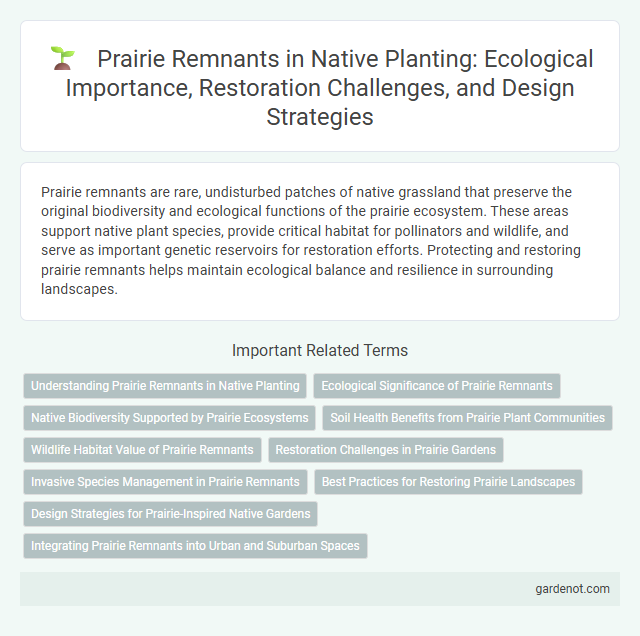Prairie remnants are rare, undisturbed patches of native grassland that preserve the original biodiversity and ecological functions of the prairie ecosystem. These areas support native plant species, provide critical habitat for pollinators and wildlife, and serve as important genetic reservoirs for restoration efforts. Protecting and restoring prairie remnants helps maintain ecological balance and resilience in surrounding landscapes.
Understanding Prairie Remnants in Native Planting
Prairie remnants represent undisturbed patches of native grasslands that provide critical habitats for diverse plant species and pollinators. Understanding prairie remnants involves studying their soil composition, native plant species diversity, and historical land use to inform restoration and conservation practices. Protecting these areas helps preserve genetic biodiversity and supports ecological resilience in native planting projects.
Ecological Significance of Prairie Remnants
Prairie remnants serve as vital ecological sanctuaries preserving native biodiversity and supporting rare plant and animal species adapted to tallgrass ecosystems. These fragments maintain essential ecosystem functions such as soil stabilization, carbon sequestration, and water filtration, contributing to landscape resilience amid widespread agricultural conversion. Protecting prairie remnants is crucial for sustaining pollinator populations and promoting genetic diversity critical for prairie restoration and climate adaptability.
Native Biodiversity Supported by Prairie Ecosystems
Prairie remnants serve as critical habitats supporting native biodiversity by preserving a diverse range of grasses, wildflowers, and animal species unique to these ecosystems. These areas provide essential resources such as food, shelter, and breeding grounds for pollinators, birds, and small mammals, promoting ecological resilience. Conserving prairie remnants helps maintain genetic diversity and ecosystem functions crucial for regional environmental health.
Soil Health Benefits from Prairie Plant Communities
Prairie remnant plant communities significantly enhance soil health by promoting deep root systems that increase soil organic matter and improve water infiltration. These native plant roots foster beneficial microbial activity and nutrient cycling, which boost soil fertility and structure. Maintaining prairie remnants supports soil carbon sequestration, reducing erosion and enhancing long-term ecosystem resilience.
Wildlife Habitat Value of Prairie Remnants
Prairie remnants provide essential wildlife habitat, supporting high biodiversity by offering food, shelter, and breeding grounds for native species such as grassland birds, pollinators, and small mammals. These areas maintain complex plant communities that contribute to ecosystem stability and resilience against environmental changes. Protecting prairie remnants ensures the preservation of critical ecological functions and native wildlife populations.
Restoration Challenges in Prairie Gardens
Prairie remnant restoration in prairie gardens faces challenges such as invasive species encroachment and soil degradation, which disrupt native plant communities. Maintaining genetic diversity of local prairie species is critical to ensure resilience against pests, diseases, and climate variability. Effective management requires adaptive strategies including controlled burns and selective planting to mimic natural processes and support ecosystem health.
Invasive Species Management in Prairie Remnants
In prairie remnants, invasive species management is critical to preserving native biodiversity and ecosystem function. Targeted removal techniques such as selective herbicide application and manual pulling help control aggressive invaders like reed canary grass and spotted knapweed. Maintaining periodic prescribed burns and monitoring invasive populations support the resilience and regeneration of native prairie plant communities.
Best Practices for Restoring Prairie Landscapes
Restoring prairie landscapes involves careful assessment of soil health, historical plant communities, and existing seed banks to ensure native species' successful reestablishment. Using locally sourced native seeds, controlling invasive species, and implementing controlled burns promote biodiversity and ecological resilience. Monitoring restoration progress through native species cover and diversity indices supports adaptive management and long-term prairie ecosystem recovery.
Design Strategies for Prairie-Inspired Native Gardens
Incorporating prairie remnants into native garden design emphasizes the use of diverse, drought-tolerant grasses like little bluestem and big bluestem to emulate natural ecosystems. Strategic layering of native wildflowers such as purple coneflower and black-eyed Susan enhances biodiversity and seasonal interest while supporting pollinators. Soil preservation and low-maintenance principles guide site selection and plant arrangement for sustainable prairie-inspired landscapes.
Integrating Prairie Remnants into Urban and Suburban Spaces
Prairie remnants serve as vital ecological reservoirs, supporting native biodiversity and offering essential habitat for pollinators in urban and suburban landscapes. Integrating these fragments into green infrastructure enhances ecosystem services like stormwater management, carbon sequestration, and native species preservation. Strategic site selection and adaptive management foster resilience against urban pressures while maintaining the genetic integrity of native prairie flora.
Prairie remnant Infographic

 gardenot.com
gardenot.com